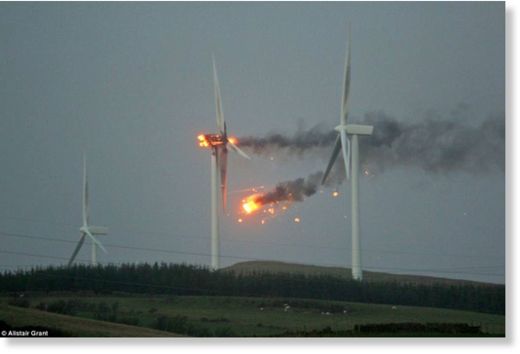- Roads, trains, ferries and airports affected across Britain
- Schools and public buildings closed down in parts of Scotland and thousands left without power

One of the most powerful storms to hit inland areas led to the closure of thousands of schools across western, central and southern Scotland, and the shutdown of almost all public buildings, including sports centres, concert halls and libraries, in cities such as Glasgow and Edinburgh.
At one stage, more than 60 train passengers were stranded on the West Highland line after it was closed down near Crianlarich, north of Loch Lomond. A rescue train was sent from Glasgow to take them off the train. The gales appeared to cause a fire in one wind turbine in Ardrossan, Ayrshire, as its blades were ripped off by the gusts.
The Met Office issued a red warning for central Scotland after air pressure across the Atlantic plunged late on Wednesday; it is thought to be the first time the Met Office has issued such a warning to "take action" for high winds rather than flooding or snow.
The phenomenon is known to meteorologists as a "weather bomb" but a Met Office spokesman said it was officially described as an "explosive deepening", which is caused when atmospheric pressure drops by 24 millibars or more in 24 hours. In Thursday's storm, air pressure fell by 44mb.
During the day, hurricane gusts bringing heavy belts of rain and hail nearly broke records, reaching 165mph on Cairngorm, where a highest speed of 173mph was measured in 1986, and 145mph at Aonach Mòr near Fort William.
Across the far more heavily populated central belt, winds hit 71mph in Bishopton in Glasgow, and 68mph at Prestwick airport in Ayrshire and Blackford Hill in southern Edinburgh. In Glasgow, one large bus company withdrew all its double deckers.
The high winds also affected Northern Ireland, northern and central England and Wales, where wind speed hit 62mph at Mumbles Head and 81mph at Aberdaron in Gwynedd.
The disruption in Northern Ireland included the cancellation of ferries from Belfast to Cairnryan, and delays for sailings to Birkenhead. Bee's Head in Cumbria experienced gusts of 74mph, with heavy flooding in areas such as Windermere. The A66 was also closed for a time.
More than 300 passengers are stranded on the Rotterdam-Hull ferry off the East Yorkshire coast. The Pride of Hull was stopped from docking to avoid damage as it entered port. In the Channel, strong winds gusting up to force 10 disrupted ferry sailings to Calais and Dunkirk, causing delays to services.
As the storms swept eastwards across Scotland, hundreds of thousands of people were sent home early as the police warned against any travel by roads on Thursday afternoon after scores of routes were closed by severe flooding, debris and fallen power lines. Universities in Glasgow were closed and classes cancelled.
Several key bridges, including the Forth road bridge, were shut as buses and high-sided vehicles were blown over when powerful gusts ripped across most areas of Scotland. There were no storm-related injuries reported by late afternoon.
Ferries in the Hebrides were suspended, nearly 40 flights to Edinburgh and Glasgow airport were cancelled and train services were suspended as Network Rail imposed a 50mph speed limit and ScotRail introduced an emergency timetable. With East Coast mainline services also disrupted, passengers were advised not to travel by train north of Edinburgh after the Tay bridge was temporarily closed and speed restrictions hit timetables.
About 30,000 people were left without electricity in pockets around Sanquhar, Dumfries, Dollar, Falkirk, Helensburgh and Stranraer after power lines were brought down by the wind. Some homes will be without power until Friday. Some patients at Belford hospital in Fort William were sent home after a power failure, which also cut its phone lines.
The Met Office spokesman said the red warning had been issued because the gales had struck large population centres, where the potential for damage and travel disruption was much greater.
"There were some extremely strong wind speeds, close to record-breaking, and that's quite unusual. What is particularly significant about this one is that some of the strongest winds are happening over populated areas. Normally these take place off the northern fringes of Scotland," he said.
Much of the potential damage was offset by urgent warnings issued by Scottish government ministers and roads agencies late on Wednesday. After a furious public backlash about its handling of last winter's ice and snow, Scottish ministers have improved early warning and contingency planning.
While there were warnings of potential blizzard conditions in northern Scotland, the Met Office predicted the winds would die down for much of the country on Friday. "The red warning expires at 9pm [on Thursday] so we would expect the winds to die down quite quickly; tomorrow is looking like a much calmer day," the Met Office said.



How long before these weather bombs starting drops mountains of snow?